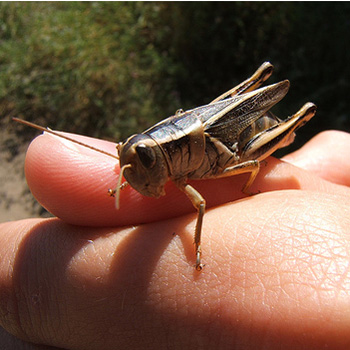Will eating insects put an end to famine? Learn more about how to become a nutritionist, and help solve the problem of malnutrition.
The Food and Agriculture Organisation (FAO) recently recommended eating insects such as bees, ants, and grasshoppers as a way to end famine. The news soon became the object of jokes, but there are actually many serious reasons behind that recommendation. As the world’s population keeps steadily growing, more experts who can assess humanity’s nutritional needs are required. Could you become one of them?

Anesthesiologists, obstetricians, surgeons, gynaecologists, and other such medical professions are in vogue and are beginning to dominate America’s top job lists, recently published by Forbes. Chief executives, actuaries and financial planners retain a favourable position, but are facing stiff competition from the biomedical sector. The popularity of these professions surely has something to do with the rapid development of the discipline. Alongside ever-growing challenges in research and its application to healthcare, raising awareness about global health issues has become a leading agenda for many countries. Nutrition and the eradication of hunger (and obesity) are some of the core preoccupations in the international field, a case in point being the G8 summit ‘Nutrition for Growth: Beating Hunger through Business and Science’, co-hosted by the British government, the Children’s Investment Fund Foundation (CIFF), and the Government of Brazil on the 8th of June in London 2013.
As of late, data released by the FAO (Food and Agriculture Organisation) have indicated that 12.5% of the world’s population (around 868 million people) are undernourished, and 26% of children worldwide are stunted by malnutrition. The results have been translated into cost-benefit analyses on the basis of the global GDP (Global Domestic Product), estimating the cost of malnutrition at two to three percent of the global GDP (1.4 trillion USD) and for non-infectious diseases (many related to obesity), a comparable 1.4 trillion USD. Nutritional issues clearly have far-reaching consequences both in terms of public health and global economics. Might dietetics and nutrition, as professions of the 21st century, offer promising prospects? With the challenges facing our planet’s population, it would certainly seem so, and E&M explores some central questions which global nutrition debates have stirred up, as well as giving some handy tips on becoming a nutritionist or a dietician.
12.5% of the world’s population (around 868 million people) are undernourished, and 26% of children worldwide are stunted by malnutrition.
Nutrition is vastly complex and presents great challenges in the 21st century. For instance, low nutritional standards have led to the UK being indecorously crowned the ‘fat man’ of Europe. Increasing concern by the Academy of Medical Royal Colleges (AoMRC) and the British Dietetic Association (BDA) has resulted in the publication of a 10-point action plan called ‘Measuring Up – The medical profession’s prescription for the Nation’s Obesity Crisis‘, which recommends 10 key measures for effectively tackling the obesity crisis in the UK. And just as Britons grow bigger, larger fractions of the planet, further away from home, suffer from other severe afflictions – micronutrient deficiency of vitamins, iron and iodine. Research has demonstrated that the first 1000 days of the child’s life are indispensable to prevent stunted growth, but in the current climate, approximately 165 million children are chronically malnourished and suffer from serious, often irreversible physical and various mental and developmental impairments.
The FAO London summit a few weeks ago scaled up global expenditure and set concrete targets: to reach 500 million pregnant women and young children with the right nutrients; to reduce the number of children under five who are stunted by an additional 20 million and save the lives of nearly 2 million by 2020. How these goals will be met is still to be seen. However, it does point to a renewed commitment to resolve the problem. Here, it will be up to specialists like nutrition scientists and dietitians to examine and revise nutritional needs and innovate in the production of and distribution of foods. They may work within the supervision of new publicly-funded or private campaigns, business initiatives or product development, such as the pioneering Plumpy Nut (1996), a paste made of a blend of vegetable oil, sugar, peanuts, non-fat milk powder, whey, vitamins and minerals for treating acute malnutrition in children, which is a variant of the RUFTs (Ready-to-Use Therapeutic Food). Or take the controversial Soylent (not sanctioned as a RUFT), a milky mix of vitamins, minerals and nutrients recently developed by the young American software engineer Rob Rhinehart, who claims it contains all that the body needs and has already hailed it as a potential ‘fuel’ to eradicate hunger. What with the projections of the world population at 9 billion by 2050, it is clear that we will have to modify our dietary habits and find alternative sources nutrients, but this will have to be done under the strict regulation of expert knowledge to test safe nutritional alternatives.
The FAO’s new report, ‘Edible Insects: Future prospects for food and feed security,’ is an important step forward in the search for environmentally sustainable dietary alternatives, and it points to the nutritional value of many insects (beetles, bees, ants, grasshoppers, worms, etc.) which can be high in protein, fat and minerals (iron, zinc, selenium, mangesium…). The report specifically addresses that farming insects for human and animal consumption is relevant at a time when population growth, urbanisation, and the rising middle class have increased the demand for food while simultaneously harming the environment that enables its production. Advantages would hence not only be environmental (lower emissions of greenhouse gases), but would also help productivity, because insects reproduce quickly, are easy to farm, and are far more efficient that cattle in their conversion of energy into meat (for each 2 kg it consumes, an insect produces 1 kg of insect mass, while a cow requires 8 kg of feed to produce the same amount). No doubt, expertise in nutrition and dietetics will be prerequisites for researching new dietary possibilities as well as raising awareness about the benefits or harms of certain dietary lifestyles.
Expertise in nutrition and dietetics will be prerequisites for researching new dietary possibilities as well as raising awareness about the benefits or harms of certain dietary lifestyles
Do you have the skills?
What exactly, you may wonder, does it take to become a nutritionist? According to the UK’s National Career Service, a good nutritionist ought be have the ability to inspire and motivate others to change their eating habits. Working as a campaigner to raise awareness about public and global health trends obviously demands excellent communication skills. The same can be said for dieticians, who must refrain from any judgemental attitudes towards their patients’ dietary lifestyles, and instead be empathetic and able to explain complex nutritional issues to people lacking a scientific background. Particularly in the case of dietetics, you may be likely to be confronted with people suffering from nutrition and lifestyle-related diseases (diabetes, obesity, heart diseases), or eating disorders (anorexia, bulimia). If public roles are not for you, there is a lot of scope for lab research posts and desk work to advance the science of nutrition, like gathering statistics, getting involved in practical nutrition research projects, and designing menus for people with specific dietary needs. In this context, the horizons of the discipline only continue to grow, as we have seen.
Where to study?
European universities offer a long list of undergraduate and graduate programmes in nutrition and dietetics, so it is worth checking what the specific requirements are in your home country. In Great Britain, for instance, you should check that courses have been accredited by the Association for Nutrition (at both bachelor and masters level). This association has published a comprehensive list of all of these programmes. By doing a tentative google search you will realise just how easy it is tailor a postgraduate programme to your particular interests, because the range of subjects to choose from is immense! If you are drawn to global nutrition, take a look at the MSc Nutrition for Global Health at the London School of Hygiene and Tropical Medice (London). Other hot subjects may be Public Health and Nutrition, Nutrition and Exercise, Nutritional Therapy, and many more. It’s best to begin by defining which subfield you want to look into, and you will be sure to find a university programme that fits right in!
Cover photo: lyzadanger; CC BY-NC-SA 2.0 (Flickr)






